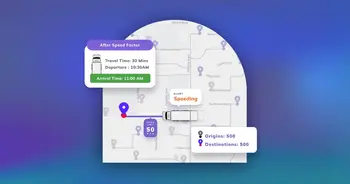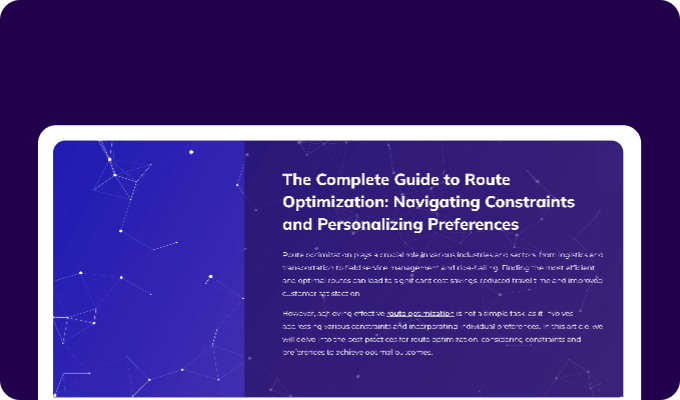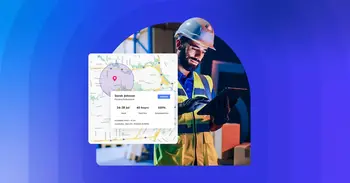When it comes to tracking your fleet of drivers and agents, Uber takes the cake.
Both for size of fleet and the quality of tracking (21 million trips per day), it has one of the most efficient tracking systems in the world. The app ensures that both driver and customer (and the company!) have a seamless tracking experience, with the process starting as soon as you tap the ‘Book ride’ button.
For products involving on-demand rides or deliveries, there are two questions to look at:
- What goes on behind the scenes to build this experience?
- How do I build navigation and tracking that’s just as robust as Uber for my product?
The second question is the bedrock of our discussion here — and the first step to tackle it starts with the realization below:
Generic mapping APIs are holding you back
And there’s a more robust, less-expensive alternative
When maps are built using generic consumer-centric APIs, businesses using them may encounter certain inherent limitations. These include:
- Inability to support unique use cases
- Scalability limitations
- Inability to account for local contexts and real-time considerations
Here’s a whitepaper that can give you more clarity on why generic APIs don’t work and why a custom map stack is a good fit for your product: Building a custom map stack with NextBillion.ai
Once you have more control over your maps, it’s time to start building the right experience for your customers and drivers/agents. Here are four ways to leverage NextBillion.ai APIs to build effective tracking for your product.
4 ways to make your tracking experience more precise
1. Tailor your routes and ETAs to your vehicles

The easiest way to get ETAs wrong is by generalizing across vehicle types.
When it comes to two-wheelers, cars, minivans, and whichever other vehicle your fleet might have — each of these have different on-road considerations. For example, the ETA for a bike, car, and mini-truck would be impacted by factors like:
- Vehicle-based road restrictions — which affects navigation
- Access restrictions at pick-up/drop-off — which affects last-mile routing
- Average speed —which impacts predicted and actual on-road time
Determining accurate ETAs can have a positive impact on your customer experience. It helps your drivers arrive at the location of the customer within the promised time window. The consequences of inaccurate ETA and bad CX result in customers cancelling rides, ultimately impacting your bottom line.
For accurate ETAs, make these on-road restrictions your strength. Track access restrictions such as one-ways, narrow roads, and roadblocks because different vehicles can navigate better on different routes. These restrictions become crucial in estimating accurate ETAs for different types of vehicles —after all, not even all 4-wheelers are created equal.
The easiest way to do this? Pull from your historic map data. NextBillion.ai’s ride hailing map solutions help you pull in the learnings from all your past rides and leverage those to ensure highly contextual maps. With that, you have access to accurate time estimates that are backed by data that your own drivers have generated.
2. Track your drivers better

The best ETA algorithms still won’t work if you don’t know where your car actually is.
In ideal conditions, you can expect your GPS data to be accurate. In most cases, conditions are far from ideal. Consider the following example:
A customer books a cab
- The cab is shown nearby, but is on the wrong side and needs to take a U-turn from some distance away
- While the driver attempts to reach the actual location, the customer’s wait time continues to increase
- Because of inaccurate location data, finding the exact pick-up and drop-off location is a challenge
Which gives us some key challenges to solve, including:
- Inaccurate ETAs and pricing, impacting driver experience
- Inaccurate navigation leading to bad customer experience
- First and last mile difficulties
GPS is rarely accurate enough to allow active tracking of your vehicles or to meet demanding client expectations. Our ‘Snap to Road can help you tackle these challenges and improve the overall customer and driver experience. It can provide accurate tracking even with noisy data, while tackling real-world scenarios such as:
- Handling on-road behavioural differences between cars, e-scooters, trucks, or other vehicles
- Accurately tracking whether vehicle is on highway vs on a service road or an exit
3. Learn from your past (rides)

A historical location store helps you store, retrieve, and analyze location data of the vehicles and drivers in your fleet. This can, in turn, help you identify valuable local contexts that are tailored to your business-case. These include:
- Routes with traffic during rush hour
- Driving behaviour —provided navigation vs actual route taken
- Marking routes with longer travel times than predicted ETAs
In most cases, this decreases dependency on live traffic data. For example: When a driver takes a different route due to road construction, which also impacts the ETA, you now have accurate data that helps you navigate other drivers accordingly.
Additionally, our APIs can help you automate a variety of use-cases, including:
- Driver payouts based on distance travelled
- Tracking driver route deviations from shown path
- Finding and reducing instances of fraud
4. Ensure robust and cost-effective mapping at scale

Generic mapping solutions follow a one-map-fits-all approach that can’t cater to the unique demands of a rapidly growing product. As you scale, optimizing the location tracking of your platform can get difficult and expensive —especially for a pay-per-API model.
As your audience and product features scale, so will your API calls to meet the larger number of incoming requests. Your platform needs to handle higher throughput, especially during peak hours and for use-cases like ride-sharing —while ensuring that your API costs don’t skyrocket.
Compared to plug-and-play mapping APIs, here’s what our APIs have to offer:
- 3-5x lower latency
- 10-20x higher throughput
- Flexible pricing models and deployment modes that are built for scale
The right time to transition is when your product is growing —not when your current technology makes growth prohibitive. NextBillion.ai has helped companies like L&T, Gojek and Freight Tiger with their mapping technology —reach out and see what we can do for you!

Build better maps with NextBillion.ai




